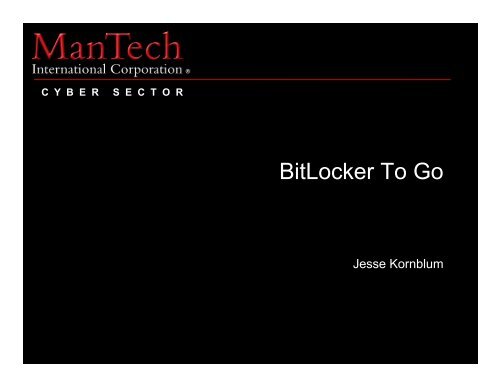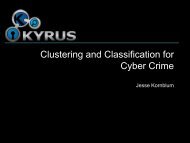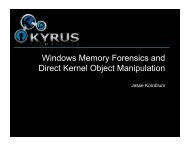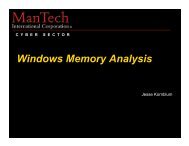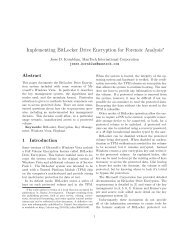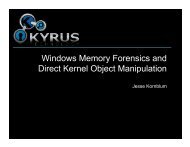BitLocker To Go - Jesse Kornblum
BitLocker To Go - Jesse Kornblum
BitLocker To Go - Jesse Kornblum
- No tags were found...
Create successful ePaper yourself
Turn your PDF publications into a flip-book with our unique Google optimized e-Paper software.
C Y B E RS E C T O R<strong>BitLocker</strong> <strong>To</strong> <strong>Go</strong><strong>Jesse</strong> <strong>Kornblum</strong>
• Introduction• While you'll see more <strong>BitLocker</strong>• What hasn't changed• Passwords• Smart Cards• Drive Layout• <strong>BitLocker</strong> <strong>To</strong> <strong>Go</strong>• Auto Unlock Keys• Incident Response• Forensics• OperationsOutline2
• <strong>BitLocker</strong> Disk Encryption (BDE)– Full Volume Encryption– Introduced with Windows Vista– Protects data at restIntroductionImage courtesy Microsoft Corporation.3
• Not widely adopted– Only came with Enterprise or Ultimate edition– Pain to install• Required hard drive repartition• Easy to lose data– Pain to use• Easy to lose dataIntroduction4
– Introduced in Windows 7 (Fall 2009)– Still only in higher end versions– Asks to upgrade existing BDE volumes• Still painful to use for fixed disks<strong>BitLocker</strong> version 25
• Can encrypt removable media– <strong>BitLocker</strong> <strong>To</strong> <strong>Go</strong> (BTG)– USB drives– Encrypts in place• As easy as right clickingWhy You'll See More <strong>BitLocker</strong>6
Why You'll See More <strong>BitLocker</strong>User right-clicks drive icon7
Why You'll See More <strong>BitLocker</strong>• <strong>BitLocker</strong> policy options– Can be configured to only allow writes to BTG protected devices• Force protection• Ideal for deployed environments– USB sticks are lost, stolen– Prevent thief from accessing data8
What Hasn't Changed• Computationally infeasible toaccess protected volumewithout a key• There is no back door• Best hope is known plaintextattack against AES-256Image courtesy Flickr user shoothead and licensed under the Creative Commons(good luck!)9
What Hasn't Changed• Data is encrypted withFull Volume MasterKey (FVEK)• FVEK is stored on disk,encrypted with VolumeMaster Key (VMK)• Many copies of VMKare stored on disk,encrypted with differentkeys• TPM, Recovery,External, etc.Image courtesy Flickr user Svadilfari and licensed under the Creative Commons10
What Hasn't Changed• Logical access to a drive is not affected– Programs do not need to know about <strong>BitLocker</strong> to access the drive• Physical access to volume– Use \\.\C: file– This file handle can be imaged• Still using AES with Elephant diffuser• <strong>BitLocker</strong> can be disabled but still encrypt the data12
What Hasn't Changed• For each particular key k– Metadata contains copy of the VMK encrypted with that key– E(VMK, k)• Metadata also contains copy of k encrypted with VMK– E(k, VMK)• Having one key means you can get all the keys– Allows user to recreate an access device– Allows us to create an access device, too13
• Let's suppose metadata contains:– E(VMK, recovery password)– E(recovery password, VMK)What Hasn't Changed– E(VMK, external key)– E(external key, VMK)– E(VMK, TPM key)– E(TPM key, VMK)14
• Volumes can be protected with a Unicode password– Documentation used "password" and "passphrase"interchangeably• Policy can control complexity requirements– By default, must be at least eight characters• <strong>To</strong> get key from password:– Hash password using SHA-256– Chain hash the result, with salt, 2 16 times• Repetitions makes brute force attacks more difficult• Salting impacts rainbow tablesPasswords15
• Volume is protected using Smart Card and PIN– Something you have and something you know– Exact method of key generation is unknownSmart CardsImage courtesy U.S. Department of Defense and is public domain16
Command Line Interface• Passwords and Smart Cards not normally used for fixed disks• But can be added using CLI• manage-bde.exe• http://technet.microsoft.com/en-us/library/dd875513%28WS.10%29.aspx17
Drive Layout• Version one munged NTFS header• From NTFS to -FVE-FS-• Also set offset 0x38 to point to metadata• Version two completely replaces NTFS header• Still has -FVE-FS- signature, but is not a valid disk header• Contains <strong>BitLocker</strong> GUID• 4967D63B-2E29- 4AD8-8399-F6A339E3D001• Appears on disk as• 3b d6 67 49 29 2e d8 4a 83 99 f6 a3 39 e3 d0 0118
Version 1 Drive LayoutDatNTFSF M M MVE-FSetadata etadata etadata19
Version 2 Drive LayoutDatNTFSF M M MVE-FSetadata etadata etadataNTFS20
Drive Layout• Metadata format changed slightly • 0x20 8 First Metadata offset• 0x28 8 Second Metadata offset• Offset Size Description• 0x00 8 Signature FVE-FS-• 0x08 2 Unknown• 0x0A 2 Version, must be 2• 0x0C 2 Unknown• 0x0E 2 Unknown• 0x10 8 Volume size, in bytes• 0x18 4 Unknown• 0x1C 4 Size of volumeheader, in sectors• 0x30 8 Third Metadata offset• 0x38 8 Offset of volume header• 0x40 4 Metadata length• 0x44 4 Unknown• 0x48 4 Unknown• 0x4C 4 Metadata length 2• 0x50 16 Volume GUID• 0x60 4 Next nonce• 0x64 4 Volume algorithm• 0x68 8 Timestamp21
• Right-click easy for USB devices• Can also be enabled from Control Panel and CLI<strong>BitLocker</strong> <strong>To</strong> <strong>Go</strong>22
<strong>BitLocker</strong> <strong>To</strong> <strong>Go</strong>• Default protection is password or smart card• Can add others using CLI• Only one password per device, sorry• Encrypts in place• Doesn't disturb underlying FAT12, FAT32, NTFS or exFAT• User can work during encryption• If space available, adds FAT32 file system with 'reader' application• More like a 'copy' application, really• Takes about 5MB• Works on Windows XP and Vista23
<strong>BitLocker</strong> <strong>To</strong> <strong>Go</strong> Drive LayoutDate xFATFAT32M etadataM etadataM etadatae xFAT24
<strong>BitLocker</strong> <strong>To</strong> <strong>Go</strong>• When using GUI, user must create a recovery key file• Series of eight groups of six digits• Saved to a file on the disk• Default name is GUID of the recovery key• Default save location is user's home directory• BUT! Key must be on a removable device to be used• Can also be typed manually25
Policy Settings• Stored in Registry• Control complexity, writing to unprotected devices• HKCU\Software\Policies\Microsoft\FVE
Auto Unlock Keys• User can configure system to automatically unlock a volume– <strong>BitLocker</strong> External Key stored in registry• HKCU\Software\Microsoft\Windows\CurrentVersion\ FveAutoUnlock\{GUID}• Key and metadata encrypted using CryptProtectData function– Uses login credentials and 3DES– Can be decrypted on the same machine27
Auto Unlock Keys28
Auto Unlock Keys• Unfortunately GUIDs in the registry correspond to auto unlock keys,not the USB device itself– Can't correlate to list of USB devices seen by a machine29
• Need the Full Volume Encryption Key• Kept in RAM when drive unlocked• Capture RAM• Search memory image for AES keys• See "Cold Boot" attack• Really searching fornot AESkey schedulesIncident ResponseImage courtesy Flickr user mape_s and used under the Creative Commons30
• Need a physical image of the drive• If the drive is mounted, can image decrypted drive!Incident Response31
Incident Response• Want the auto unlock keys in the registry• Grab contents of• HKCU\Software\Microsoft\Windows\CurrentVersion\FveAutoUnlock• Decrypt using user credentials32
• Look for written down/printed out recovery key• Eight groups of six digits• Each group is a multiple of 11• Look for Recovery key files• Unicode text• Contain string "Full recovery key identification:"• Look for External key files• Should be stored on USB devices• .BEK extensionIncident Response33
• Look for clear key• Indicates <strong>BitLocker</strong> has been disabledForensics34
• Password cracking• About 0.8 seconds per guess• Time spent in chain hashing• Makes brute force generally infeasible• Key guessing• Easiest attack is against FVEK• Known plaintext attack against AES-256• 2 128 possible keys, all equally likely• <strong>Go</strong>od luck!Forensics35
Forensics• Try it out!• There's a BTG protected volume in the 2010 DC3 ForensicsChallenge• http://dc3.mil/challenge/2010/Image courtesy U.S. Department of Defense and is public domain36
Interrogation(this slide intentionally left blank)37
• Look for evidence of use on XP and Vista systems• Prefetch files for <strong>BitLocker</strong><strong>To</strong><strong>Go</strong>.exeForensics38
• Can add an access device• Remember, only one password per device• But external keys or recovery keys are fair game• Can recreate an access device• Use stored copies of the VMK• Can copy auto unlock keys from one computer to another• Have to be decrypted and re-encryptedOperations39
• Introduction• While you'll see more <strong>BitLocker</strong>• What hasn't changed• Passwords• Smart Cards• Drive Layout• <strong>BitLocker</strong> <strong>To</strong> <strong>Go</strong>• Auto Unlock Keys• Incident Response• Forensics• OperationsOutline40
Questions?<strong>Jesse</strong> <strong>Kornblum</strong>jesse.kornblum@mantech.comImage courtesy Flickr user ella_marie and licensed under the Creative Commons41


